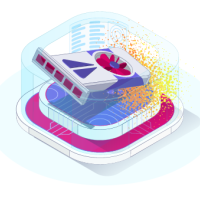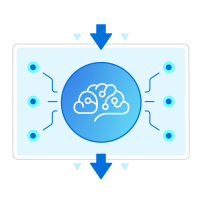What is Web3?
By combining blockchain tech and peer-to-peer networking, Web3 allows you to wrestle the ownership of your data out of the hands of big tech and put it back into your own. This drives up privacy and security rates massively, all while reestablishing trust and independence in the online space.

A brief history of the web
To understand what is Web3, you first need to go back and study the origins and evolution of the world wide web and its first two incarnations:
Web1: Reading room only
First came Web1, known as the Read-Only era, which ran between 1990 and 2004. Web1 was developed by the English computer scientist Tim Berners-Lee in 1989 while he was working at the scientific research organisation, CERN. Web1 was basic, only allowing users to visit internet web sites and read the content stored there. From news and weather to sports and entertainment, you could read whatever you wanted on the world wide web – but could never actually interact with any of the content beyond clicking on links.
Web2: Going interactive
Now enter Web2 in 2004. Its arrival was marked predominantly by the birth of social media platforms, that offered personalised news feeds and the ability to interact with the web. This enabled user-generated content as well as interactions between users, all on the world wide web. It’s why Web2 is known as the Read-Write era.
Interactivity across the web has and continues to grow thanks to powerful but relatively simple programming languages such as CSS and JavaScript. These enable web devs to create websites tailored to users and their preferences (think of Facebook’s social media newsfeeds or Amazon recommending products that are personalised to your preferences).
Web2: The problem
There’s a catch, however. All user information and preferences – your data – are owned and managed by the big tech companies running the websites you visit, creating a centralized approach. Such data is rich in insights and can be used to produce targeted ads delivered right to your browser. In fact, that’s how Google makes its money – ads make up over 80% of its revenue. It also explains why companies like Google and Facebook are so eager to give you free access to their services and content as your data is worth so much to them.
Web2: Loss of control
Ultimately, this setup means you’re not in control of your own data or digital assets – and how they are used or stored. Instead, data is centralized and ‘leveraged’ via the network, servers and databases owned by the website or web service owner you’ve submitted it to. In turn, this arrangement is open to harm such as data breaches that provide bad actors with your personal data and content, or for exploitation by companies or governments that may have their own political/ideological agendas.
Web3: Taking back ownership
It’s against this backdrop that Web3 meaning has taken shape. Its concept was coined back in 2014 by Gavin Wood, the co-founder of Ethereum, the decentralized blockchain platform (more on blockchain later). The Web3 concept itself? It states we all trust way too much, putting sometimes highly sensitive data into the hands of a select few private companies that must be ‘trusted’ to access and use it ethically.
This is a no-no, according to the Web3 community including Wood. Instead, the community claims, we need to decentralise all data to take back control of it – and Web3 technology is how we’re going to do it. In other words, creating the next generation of the world wide web for a new Read-Write-Own era.
Web3 definition
Web3 isn’t a single ‘entity’; its premise involves a range of technologies, components and applications that, when combined, create – in theory – the potential for an internet where you are put back in control; where information is decentralized; trust and transparency can be reestablished on the internet, and data ownership is put back in the hands of users. Web3 technology’s five core components are:
Web3: Blockchain
Blockchain has garnered a mass of headlines and soundbites over the past few years but in the real world terms, what is blockchain technology? It’s a Web3 digital ledger infrastructure designed to keep data secure, without the need for a central authority or third-party. Blockchain networks consist of multiple distributed participants – known as nodes – that work together to validate transactions. This is how the tech works:
- The data for each Web3 transaction is stored on blocks and linked together in a chain
- Each block contains a cryptographic hash of the previous block
- This ensures the data is tamper-proof and immutable
- It also offers a transparent view of the entire transaction.
In theory, Web3’s blockchain is a game-changing technology, offering unprecedented benefits for business, government and society – and individual users:
- Blockchain keeps Web3 data secure within a trusted space
- Blockchain offers an end-to-end view of the Web3 transaction journey
- Blockchain guarantees the integrity of data and offers unprecedented levels of transparency
- The transparency offered by blockchain is unavailable from traditional databases and centralized services.
Web3: Cryptocurrency
This is like a Euro or a dollar but is only available in digital or virtual form, and can only be used on Web3 blockchains. Its greatest strength – as cited by advocates – is there is no government or bank controlling the currency. Instead, in Web3’s push for decentralisation, crypto currency allows for direct digital transactions between users, cutting out the middle man entirely. In conjunction with blockchain, this means the cost of Web3 transactions are reduced – i.e., no handling fees – plus Web3 payments are quicker and more secure (so long as you have access to high transactional performance with IOPS instances).
That’s the theory at least. In practise, we’ve already witnessed the hugely volatile nature of digital currencies as well as the many scandals surrounding their regulation. One thing though remains certain – Web3’s cryptocurrency is here to stay whether traditional financial institutions like it or not.
Web3: NFT
A Web3 non fungible token (NFT) is a unique digital asset whose ownership is provable via blockchain. Typically used within sectors such as gaming and art, imagine Web3 NFTs as verified digital collectibles – say, digital artwork – that can be bought outright or traded in for another Web3 NFT. And there’s serious money to be made. For instance, the digital artwork Everydays: The First 5000 Days by Beeple made over $69 million when its NFT was put up for auction.
Business is already leveraging the potential of Web3 non fungible tokens to generate new revenue sources and drive user engagement. For instance, NBA Top Shot is an NFT marketplace where basketball video clips can be bought, sold or traded by sports fans.
Web3: Decentralised Applications (DAPPs)
Unlike traditional software applications that run on a single computer, Web3 DAPPs are run over a blockchain network, i.e., peer-to-peer. Crucially, once the original build has been completed by developers and the resulting app released, Web3’s DAPPs’ decentralized structuring allows other developers to carry out further work on the build as they see fit without any single authority exerting control over outcomes.
In other words, the complete decentralisation of applications build and development. This makes Web3 DAPPs always accessible and without central points that could fail, meaning they are more robust than traditional applications.
Viewable within web pages via your browser, Web3 DAPPs are already being used out in the wild. Examples include Uniswap, the decentralized crypto exchange platform and Brave Browser. The latter is optimised for user privacy as well as deploying Web3 tokens (Basic Attention Token) that reward users for watching online ads, which can then be converted into cryptocurrency.
Web3: Decentralized Autonomous Organisation (DAO)
A vital component of Web3, DAOs are designed to establish management structures that no centralized single party or community can control. Instead, any decision making is voted on by all stakeholders via smart contracts (see below). The aim? To deliver more democracy and decentralisation to the web, instead of placing all the power in the hands of a select few, i.e., big tech companies.
Web3: Smart contracts
Put simply, Web3’s smart contracts automate actions once pre-defined conditions have been met, i.e., if something has been done, then automatically move on to the next step. Smart contracts can be applied to multiple scenarios from releasing funds to automating entire workflows, such as supply chains (see below).
What are the business use cases of Web3?
While we’ve touched on the many benefits for users, what are the tangible advantages and Web3 technology use cases for business? Much of the content written about Web3 often frames enterprise as the ‘bad guy’, exploiting user data for financial gain or sourcing unique customer insights unscrupulously.
In fact, most enterprise simply wants to understand, support and protect customers better, all while improving internal work flows and processes. The aim? To improve earnings and grow the business using new technology. Simple.
Within this context, Web3 could prove to be transformative as well. For instance:
Securing supply chains
By using blockchain, Web3 technology can offer huge gains for supply chain management from greater transparency and accountability through to massively improved tracking of products at each and every point in the chain. This would be particularly invaluable for identifying counterfeit products. Much is also being made of Web3’s ‘smart contracts’ and their ability to automate typically time-consuming processes including delivery confirmations and payments.
Improving cost efficiency
By leveraging machine learning and artificial intelligence – via solutions such as OVHcloud’s AI Deploy – Web3’s smart contracts can help streamline operations and automate workflows, reducing operational costs in the process. Web3 technology can also remove the need for intermediaries such as payments processors and banks from financial transactions as all payments are made peer-to-peer.
Protecting intellectual property
The deployment of non fungible tokens via Web3 blockchains can help protect intellectual property by offering a complete digital record of the IP including its ownership and provenance. Importantly, the NFT is almost tamper-proof. This means if IP is suspected of being ‘co-opted’ by a third party, there is an indisputable Web3 record available to take action against any copyright infringement and the people behind it.
Enhancing data security
Web3 technology allows data to be distributed across an enterprise network. This not only increases resilience and reduces the potential of single points of failure but also boosts data integrity as data sets are rendered tamper-proof. Critically, the risks represented by having data stored within a centralized storage solution are sidestepped entirely. Such comprehensive feature sets are crucial for sectors that handle highly sensitive data such as healthcare.
The future of Web3
First, it’s important to be realistic about Web3 technology and not take the hyperbole surrounding it as fact. It’s also worth bearing in mind that Web3 is still new and in its infancy compared to Web2. Because of this, you will have already heard the horror stories about cryptocurrencies, people running NFTs scams, and more. We recommend:
Looking before leaping
Just as with any emerging technology or platforms, it’s important to step back and take a dispassionate look at what capabilities and features are being offered by the new technologies – and what the risks are. For instance, while decentralisation is a core pillar of Web3 technology’s offering, a DAPP may still be majority-controlled by a single company or entity. Also, the space remains mostly unregulated, representing something of Wild West for people venturing out into the Web3 landscape for the first time.
Considering the risk
While decentralisation has the potential to improve society by increasing transparency and removing corruption, it can also be used by criminals to hide behind anonymity. Bad actors can also use Web3’s blockchain and cryptocurrency to transfer money without using a bank, make transactions on the dark web, and encrypt malicious files using the power of the cryptographic hash.
Finally, you should also consider the impact on the environment. Remember, Web3 relies on blockchain, a technology that requires huge computational power such as that delivered by GPU cloud technology, and can consume vast amounts of energy. For instance, to create Bitcoin for trading and spending uses up 91 terawatt-hours of electricity each year – that’s more than used by Finland annually.

Taking a long term view
However, even with the above caveats, Web3 and its services still offer massive potential. It’s why any forward-thinking enterprise must begin exploring the opportunities represented by Web3. For instance, focus on identifying potential use cases, developing a coherent Web3 strategy, educating stakeholders, and considering how to plan and introduce pilot projects to gain the right foothold before introducing change across the entire company. Ultimately, however you decide to proceed, a failure to act soon risks being left behind by more progressive competitors that decide to make the leap now.




